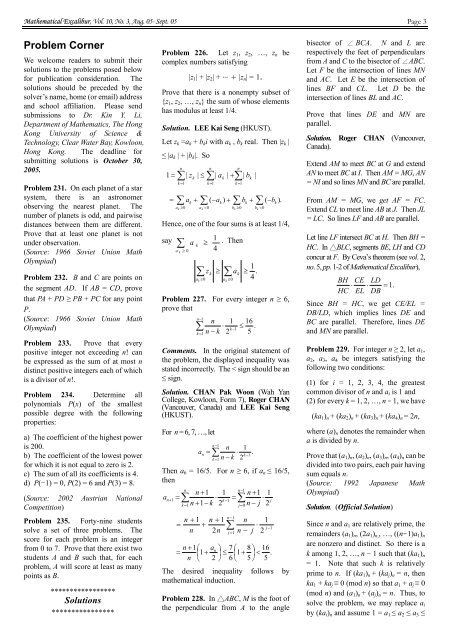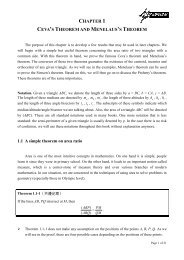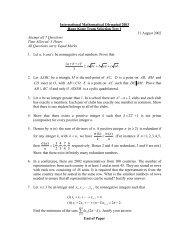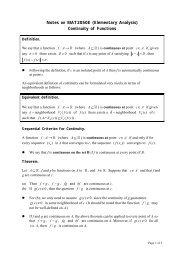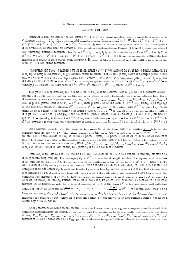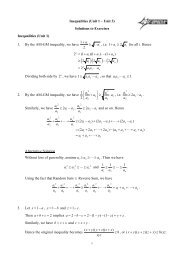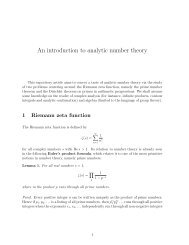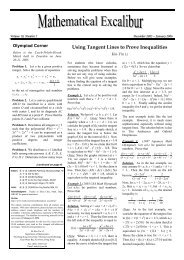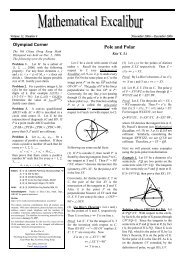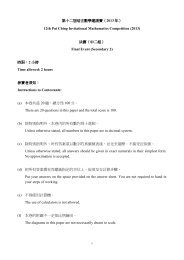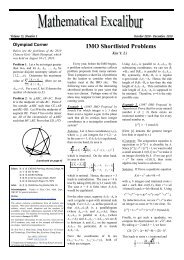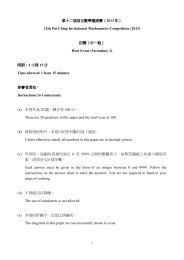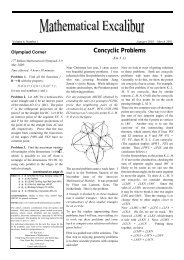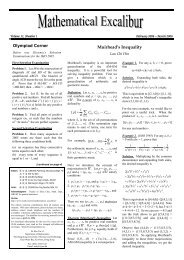Famous Geometry Theorems - Department of Mathematics - The ...
Famous Geometry Theorems - Department of Mathematics - The ...
Famous Geometry Theorems - Department of Mathematics - The ...
You also want an ePaper? Increase the reach of your titles
YUMPU automatically turns print PDFs into web optimized ePapers that Google loves.
Mathematical Excalibur, Vol. 10, No. 3, Aug. 05- Sept. 05 Page 3<br />
Problem Corner<br />
We welcome readers to submit their<br />
solutions to the problems posed below<br />
for publication consideration. <strong>The</strong><br />
solutions should be preceded by the<br />
solver’s name, home (or email) address<br />
and school affiliation. Please send<br />
submissions to Dr. Kin Y. Li,<br />
<strong>Department</strong> <strong>of</strong> <strong>Mathematics</strong>, <strong>The</strong> Hong<br />
Kong University <strong>of</strong> Science &<br />
Technology, Clear Water Bay, Kowloon,<br />
Hong Kong. <strong>The</strong> deadline for<br />
submitting solutions is October 30,<br />
2005.<br />
Problem 231. On each planet <strong>of</strong> a star<br />
system, there is an astronomer<br />
observing the nearest planet. <strong>The</strong><br />
number <strong>of</strong> planets is odd, and pairwise<br />
distances between them are different.<br />
Prove that at least one planet is not<br />
under observation.<br />
(Source: 1966 Soviet Union Math<br />
Olympiad)<br />
Problem 232. B and C are points on<br />
the segment AD. If AB = CD, prove<br />
that PA + PD ≥ PB + PC for any point<br />
P.<br />
(Source: 1966 Soviet Union Math<br />
Olympiad)<br />
Problem 233. Prove that every<br />
positive integer not exceeding n! can<br />
be expressed as the sum <strong>of</strong> at most n<br />
distinct positive integers each <strong>of</strong> which<br />
is a divisor <strong>of</strong> n!.<br />
Problem 234. Determine all<br />
polynomials P(x) <strong>of</strong> the smallest<br />
possible degree with the following<br />
properties:<br />
a) <strong>The</strong> coefficient <strong>of</strong> the highest power<br />
is 200.<br />
b) <strong>The</strong> coefficient <strong>of</strong> the lowest power<br />
for which it is not equal to zero is 2.<br />
c) <strong>The</strong> sum <strong>of</strong> all its coefficients is 4.<br />
d) P(−1) = 0, P(2) = 6 and P(3) = 8.<br />
(Source: 2002 Austrian National<br />
Competition)<br />
Problem 235. Forty-nine students<br />
solve a set <strong>of</strong> three problems. <strong>The</strong><br />
score for each problem is an integer<br />
from 0 to 7. Prove that there exist two<br />
students A and B such that, for each<br />
problem, A will score at least as many<br />
points as B.<br />
*****************<br />
Solutions<br />
****************<br />
Problem 226. Let z 1 , z 2 , …, z n be<br />
complex numbers satisfying<br />
|z 1 | + |z 2 | + ⋯ + |z n | = 1.<br />
Prove that there is a nonempty subset <strong>of</strong><br />
{z 1 , z 2 , …, z n } the sum <strong>of</strong> whose elements<br />
has modulus at least 1/4.<br />
Solution. LEE Kai Seng (HKUST).<br />
Let z k =a k + b k i with a k , b k real. <strong>The</strong>n |z k |<br />
≤ |a k | + |b k |. So<br />
1 =<br />
=<br />
n<br />
∑<br />
k = 1<br />
∑<br />
| z<br />
a<br />
k<br />
ak<br />
≥0<br />
k<br />
+<br />
| ≤<br />
∑<br />
n<br />
∑<br />
ak<br />
< 0<br />
| a<br />
| +<br />
n<br />
∑<br />
k<br />
k = 1 k = 1<br />
( −a<br />
) +<br />
k<br />
∑<br />
k<br />
bk<br />
≥0<br />
| b |<br />
b<br />
k<br />
+<br />
∑<br />
bk<br />
< 0<br />
( −b<br />
).<br />
Hence, one <strong>of</strong> the four sums is at least 1/4,<br />
say<br />
∑<br />
a k ≥ 0<br />
a<br />
k<br />
∑<br />
≥<br />
ak<br />
≥0<br />
1<br />
4<br />
. <strong>The</strong>n<br />
z k<br />
≥ ∑ a<br />
k<br />
ak<br />
≥0<br />
≥<br />
1<br />
.<br />
4<br />
Problem 227. For every integer n ≥ 6,<br />
prove that<br />
n<br />
∑ − 1<br />
k=<br />
1<br />
n<br />
n<br />
1<br />
⋅<br />
− k 2<br />
16<br />
5<br />
≤ .<br />
k−1 Comments. In the original statement <strong>of</strong><br />
the problem, the displayed inequality was<br />
stated incorrectly. <strong>The</strong> < sign should be an<br />
≤ sign.<br />
Solution. CHAN Pak Woon (Wah Yan<br />
College, Kowloon, Form 7), Roger CHAN<br />
(Vancouver, Canada) and LEE Kai Seng<br />
(HKUST).<br />
For n = 6, 7, …, let<br />
n−1<br />
n 1<br />
an<br />
= ∑ ⋅ .<br />
k −1<br />
n − k 2<br />
k = 1<br />
<strong>The</strong>n a 6 = 16/5. For n ≥ 6, if a n ≤ 16/5,<br />
then<br />
a<br />
n<br />
n−1<br />
n + 1 1 n + 1<br />
n+<br />
1<br />
= ∑ ⋅ = ⋅<br />
k −1<br />
∑<br />
k = 1 n + 1−<br />
k 2 j=<br />
0 n − j<br />
1<br />
j<br />
2<br />
n−1<br />
n + 1 n + 1 n 1<br />
= + ∑ ⋅<br />
j<br />
n 2n<br />
n + 1⎛ a<br />
⎜1<br />
+<br />
n ⎝ 2<br />
=<br />
n<br />
⎞ ⎟ ≤<br />
⎠<br />
−1<br />
j = 1 n − j 2<br />
7 ⎛ 8 ⎞ 16<br />
⎜1<br />
+ ⎟ < .<br />
6 ⎝ 5 ⎠ 5<br />
<strong>The</strong> desired inequality follows by<br />
mathematical induction.<br />
Problem 228. In △ABC, M is the foot <strong>of</strong><br />
the perpendicular from A to the angle<br />
k<br />
bisector <strong>of</strong> ∠ BCA. N and L are<br />
respectively the feet <strong>of</strong> perpendiculars<br />
from A and C to the bisector <strong>of</strong> ∠ABC.<br />
Let F be the intersection <strong>of</strong> lines MN<br />
and AC. Let E be the intersection <strong>of</strong><br />
lines BF and CL. Let D be the<br />
intersection <strong>of</strong> lines BL and AC.<br />
Prove that lines DE and MN are<br />
parallel.<br />
Solution. Roger CHAN (Vancouver,<br />
Canada).<br />
Extend AM to meet BC at G and extend<br />
AN to meet BC at I. <strong>The</strong>n AM = MG, AN<br />
= NI and so lines MN and BC are parallel.<br />
From AM = MG, we get AF = FC.<br />
Extend CL to meet line AB at J. <strong>The</strong>n JL<br />
= LC. So lines LF and AB are parallel.<br />
Let line LF intersect BC at H. <strong>The</strong>n BH =<br />
HC. In △BLC, segments BE, LH and CD<br />
concur at F. By Ceva’s theorem (see vol. 2,<br />
no. 5, pp. 1-2 <strong>of</strong> Mathematical Excalibur),<br />
BH<br />
HC<br />
CE<br />
⋅ ⋅<br />
EL<br />
LD<br />
DB<br />
= 1.<br />
Since BH = HC, we get CE/EL =<br />
DB/LD, which implies lines DE and<br />
BC are parallel. <strong>The</strong>refore, lines DE<br />
and MN are parallel.<br />
Problem 229. For integer n ≥ 2, let a 1 ,<br />
a 2 , a 3 , a 4 be integers satisfying the<br />
following two conditions:<br />
(1) for i = 1, 2, 3, 4, the greatest<br />
common divisor <strong>of</strong> n and a i is 1 and<br />
(2) for every k = 1, 2, …, n – 1, we have<br />
(ka 1 ) n + (ka 2 ) n + (ka 3 ) n + (ka 4 ) n = 2n,<br />
where (a) n denotes the remainder when<br />
a is divided by n.<br />
Prove that (a 1 ) n , (a 2 ) n , (a 3 ) n , (a 4 ) n can be<br />
divided into two pairs, each pair having<br />
sum equals n.<br />
(Source: 1992 Japanese Math<br />
Olympiad)<br />
Solution. (Official Solution)<br />
Since n and a 1 are relatively prime, the<br />
remainders (a 1 ) n , (2a 1 ) n, , …, ((n-1)a 1 ) n<br />
are nonzero and distinct. So there is a<br />
k among 1, 2, …, n − 1 such that (ka 1 ) n<br />
= 1. Note that such k is relatively<br />
prime to n. If (ka 1 ) n + (ka j ) n = n, then<br />
ka 1 + ka j ≡ 0 (mod n) so that a 1 + a j ≡ 0<br />
(mod n) and (a 1 ) n + (a j ) n = n. Thus, to<br />
solve the problem, we may replace a i<br />
by (ka i ) n and assume 1 = a 1 ≤ a 2 ≤ a 3 ≤


